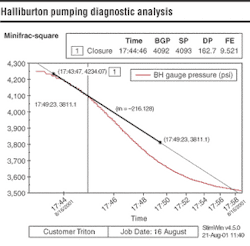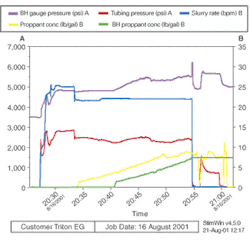First frac pack treatment in a deepwater West Africa field
E.B. Claiborne Jr.,Amerada Hess Co.
R.H. Jones, M. Van Domelen, Halliburton
A frac pack treatment performed for Triton/Hess in Equatorial Guinea, West Africa, on the Ceiba No. 5 well was the first completion of this type performed in this deepwater field and resulted in the highest rate completion in the field to date.
The Ceiba field is located offshore Equatorial Guinea in a water depth of 799 m. The reservoir is Coniacian-to-Campanian in age and is dominated by thick, very fine to coarse-grained sandstones, siltstones, and interbedded claystones. The reservoir exhibits fair to excellent reservoir characteristics and is terminated by a flooding event of Intra- to Upper-Campanian Age. The main reservoir sands are clean and have little clay content, with the exception of minor amounts of kaolinite. Some of the characteristics of the reservoir are:
- ± 330-ft gross interval
- Multiple high permeability sand lobes and lower permeability laminated sand/shale sequence
- Permeability averages 500 md with streaks in main channels of 5-8 darcies
- Porosity ±26%
- 8.7 ppg equivalent mud weight reservoir pressure
- 205° F bottom hole static temperature
- 9 5/8-in. production casing in 12 1/4 in. well bores
- 5 1/2-in. production tubing.
The initial Ceiba wells were completed as cased hole internal gravel packs utilizing a viscoelastic surfactant carrier fluid. The best completion skins obtained in these wells were in the range of 10-15, indicating less than optimal completions.
The Ceiba 5 frac pack treatment was performed using the Halliburton Energy Services stimulation vessel War Admiral, based out of Soyo, Angola. During the frac pack stimulation, 35,500 lb of proppant was placed into the formation at pump rates of up to 25 bbl/min, and an additional 5,900 lb was placed to pack the screen casing area.
The well inflow performance (IP) was the highest recorded in the field at 29,912 b/d and 15.18 MMcf/d gas. Initial skin was 1.3, which improved after six months to a negative skin of -0.8. This data was obtained from permanent down hole pressure and temperature gauges installed in the Ceiba 5 completion tubing string and monitored from the FPSO. The low completion skin was very encouraging. The results on the Ceiba 5 completion was a dramatic improvement upon the results that were obtained on the initial four completions using cased hole viscoelastic surfactant, moderate rate technology.
Initial design
The frac pack design used single trip tool systems that were available in country at the time of completion. The layered formations of the Ceiba 5 completion interval presented the challenge of obtaining a frac pack design capable of penetrating all the layers and obtaining a good annular gravel pack. The interval was composed of the following rock strata: the lower 24 m of productive formation was separated from the upper 24 m productive section by a 14 m nonproductive shale/sand section. Formation permeabilities were in excess of 1 darcy.
With this large, multi-layered reservoir scenario, there was considerable concern that the high fluid leak off of the hydraulic stimulation would hinder fracture development, and two fractures could be competing during the stimulation treatment. The combination of high leak off and multiple fractures could prevent the successful stimulation of these intervals. With this well being completed in two distinct sand formation sections, the annular packing of the screen was a concern. Based on the above, the decision was made to employ alternative flow path screens to assist in annular packing during the later stages of the frac pack treatment, and to focus on accurate monitoring and control of fluid loss during the treatment.
The specific conditions to design the frac pack for the well were:
- Casing: 9 5/8 in. 47-53.5 ppf N-80, inside diameter (ID) of 8.681 in.
- Perforations: 2,420-2,444 m & 2,458-2,482 m MD, 2,380-2,404m & 2,416-2,440 m TVD
- Bottomhole temp: 205° F
- Estimated permeability: 500-1,000 md
- Porosity: 23%
- Bottom hole pressure: 3,486 psi
- Deviation through zone: 2-3°.
Stimulation fluids
To maximize fracture conductivity, a low polymer base crosslinked fluid system with an aggressive optimized breaker package was used as the stimulation fluid for the pad and sand-laden fluids. This fluid system has been proved to provide low fluid leakoff and high fracture conductivities in similar deepwater frac pack applications.
Temperature prediction
A wellbore temperature simulation was performed to predict the cool down during the frac pack stimulation. The simulated minimum bottom-hole temperature was used to design the cross linker and aggressive breaker schedules for the frac pack fluid system.
Retrievable downhole pressure and temperature gauge data recorded a minimum temperature of 97° F during the frac pack stimulation. The model simulation predicted a minimum bottom-hole temperature of 99° F.
Minifrac
Before performing the main treatment, a minifrac was performed to assist with the main treatment design. The primary objectives of the minifrac are:
- To evaluate how well the fracturing fluid helps to control leakoff from the fracture into the formation
- To determine the fracture closure pressure
- To ensure that the fracture simulator is adequately modeling the pressure behavior in the fracture using net pressure matching.
To perform the main minifrac, crosslinked fluid was first spotted into the well in reverse position. With the fracturing fluid in the workstring, the tool was placed in squeeze position, and the remainder of the job was pumped. After pumping the desired volume of crosslinked gel, the workstring was displaced by linear gel.
Minifrac analysis
The first step in the minifrac analysis process was to evaluate the pressure decline curve to determine fracture closure pressure. Where the decline curve deviates from straight-line behavior is typically noted as the fracture closure point. From this analysis, the fracture closure pressure was observed at a value of 4,092 psi, with a corresponding fluid efficiency of 9.5%.
While a good pressure match was obtained for the pressure decline after shut-in, the observed net pressure during pumping did not match the predicted net pressure very well. The actual net pressure, based on the downhole gauge data, was at least 500 psi higher than normally expected due to excessive fracture entry friction (which was observed by the drop in downhole gauge pressure at shut-in).
Normally, excessive fracture entry friction can be attributed to either the simultaneous propagation of more than one hydraulic fracture or an inefficient connection between the fracture and the wellbore. Based upon additional data observed later during the main frac pack, it is more likely that two independent hydraulic fractures, perhaps connected through the middle zone shale barrier, were being propagated during pumping.
Design and treatment
Based on the results of the minifrac, several sensitivity runs were made to obtain a design for the main treatment. The main parameters that varied during this phase include the pad volume and the various proppant stages.
The main treatment plot shows that the moment proppant began entering the formation, the pressure rose from 4,750 psi to 5,500 psi during pumping, with a final initial shut-in pressure (ISIP) of 5,200 psi. Although there were many rises and drops in pressure during the proppant stages, two distinct "screenouts" occurred. The first screenout appears likely to have occurred at a time of 20:47 (at 4 ppg downhole), after the bottom-hole pressure had already risen by 650 psi above the base value from the pad stage. After this first screenout, the bottom-hole pressure broke back by approximately 200 psi. The second screenout occurred at the end of the job, after the bottom-hole pressure had risen and additional 250 psi (at 7.3 ppg proppant concentration downhole at the perforations).
Shortly after the 7-ppg stage reached the perforations, a final screenout resulted in a surface tubing pressure spike. The tubing pressure reached a value of 2,600 psi, and the electronic pump kickouts properly triggered the pump shutdowns.
A total of 77,200 lb of proppant was pumped during the job, with about 35,500 lb entering the formation and 5,900 lb in the screen/blank annular area. The remaining 35,800 lb was reversed out of the well after the screenout.
Analysis
Based on the data recorded during this job, along with the nature of this reservoir (two pay zones with a large shale in between), it is plausible to conclude that a complex fracture geometry likely existed during this frac pack treatment. Based on the surface and downhole gauge data, the following conclusions were observed:
- An excess fracture friction of around 500 psi existed throughout the job, which was an indication of either fracture tortuosity or multiple fractures being simultaneously propagated. Normally, if fracture tortuosity exists, it is removed as the first proppant stages enter into the fracture. Since this excess friction was not removed as proppant entered the fracture, it was concluded that two fractures were likely present during the job, possibly connected through the shale zone in between. This excess friction
- was not readily evident from the tubing head pressure measured during the job.
- Two distinct screenouts were observed as proppant was pumped into the fracture(s). The first screenout occurred after the 1-4 ppg stages (14,000 lb of proppant), and the second screenout occurred after pumping the remainder of the proppant (4-7 ppg stages and 21,500 lb of proppant)
- Many small drops, then rises, in the bottomhole pressures were observed over the course of the job. These small break backs in pressure may be an indication that fracture height growth did occur, likely helping to cover a significant portion of the overall height of the pay zones
- Nearly 1,000 psi of net fracture packing was observed in place during the main treatment. This can be derived from the difference between the ISIP after the minifrac (4,250 psi), and the ISIP after the frac pack (5,200 psi)
- The maximum bottom-hole pressure recor-ded downhole during the final screenout was 6,200 psi, well below the established limit of 7,810 psi (collapse rating of weakest link plus reservoir pressure) from maximum pressure calculations performed during design phase.
The net pressure rise of 950 psi during this job indicates that a tip screenout with excellent fracture packing was obtained. The successful fracture packing commonly results in a high fracture conductivity and low completion skin, and in fact did provide for a very good overall well response to the treatment.
A summary of the final fracture conditions derived from pressure match correlation is:
- Propped fracture length: 93.9 ft
- Propped fracture height: 75 ft
- Propped fracture width at wellbore: 0.8 in.
- Maximum proppant concentration into perfs: 8 ppg
- Net pressure rise: 950 psi
- Maximum prop concentration in frac: 7 lb/gal.
Summary
Several factors presented a challenge in designing and implementing the Ceiba 5 hydraulic fracture stimulation job. The primary challenges were the outstanding reservoir permeability, which resulted in high fluid leakoff, and a large net pay height, which resulted in low fluid efficiencies. Proper planning and execution resulted in an excellent completion based on the resultant low skin/low draw-down, high-productivity index, and high production rates.
Acknowledgements
The authors would like to thank the management of Amerada Hess and Halliburton Energy Services for permission to share this information with the industry.



